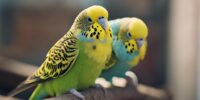What Are the Best Practices for Setting up a Budgerigar (Budgie) Cage?
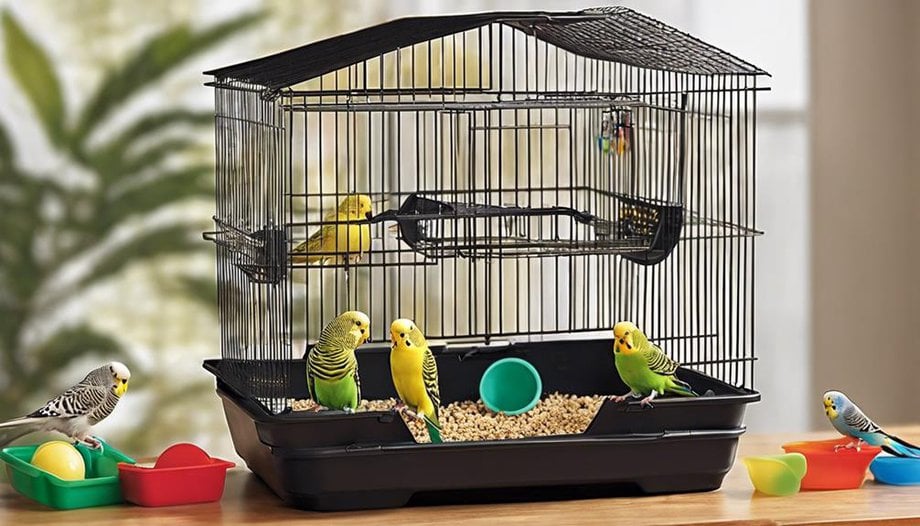
When setting up a budgerigar cage, there are several best practices to ensure the well-being and comfort of your pet bird.
- Cage Size:
It is important to provide a spacious cage for your budgerigar to allow for adequate movement. The minimum recommended size for a budgerigar cage is 18x18x18 inches.
- Perches and Toys:
Include a variety of perches of different sizes and textures to promote foot health and exercise. Additionally, provide toys such as bells, ropes, and mirrors to keep your budgerigar mentally stimulated.
- Food and Water:
Ensure that your budgerigar has access to fresh food and water daily. Place food and water dishes in easily accessible locations within the cage.
- Cleaning and Maintenance:
Regularly clean your budgerigar’s cage to maintain a hygienic environment. Replace bedding, wash toys, and disinfect the cage on a routine basis.
- Location:
Place the cage in a well-lit area with natural light, but avoid direct sunlight exposure. Keep the cage away from drafts and areas with fluctuating temperatures.
By following these best practices, you can create a comfortable and enriching environment for your budgerigar to thrive in.
Cage Size
When selecting a cage size for a budgerigar, consider the bird’s need for space to move and stretch its wings comfortably. Budgerigars are active and energetic creatures that require ample room to exercise and explore. A cage that’s too small can lead to stress and health issues. Ensure the cage is spacious enough to accommodate perches, toys, and feeding dishes while still allowing the budgerigar to fly short distances within the enclosure.
Incorporating cage decorations can enhance the aesthetic appeal of the budgerigar’s environment. Providing natural branches, ropes, and toys not only offers mental stimulation but also encourages physical activity. Additionally, adding colorful items can create a visually appealing space for both the bird and its human companions.
Proper ventilation and air circulation are crucial factors to consider when setting up a budgerigar cage. Adequate airflow helps maintain a healthy environment by reducing moisture build-up and preventing the growth of harmful bacteria. Choose a cage design that allows for good ventilation to promote the well-being of your feathered friend.
Location and Placement

Proper placement of the budgerigar cage is essential to ensure the bird’s well-being and comfort. When deciding on the location for the cage, consider areas that provide natural lighting and good ventilation. Budgies thrive in environments with access to sunlight, which supports their overall health and mood. Additionally, adequate ventilation helps maintain air quality within the cage, reducing the risk of respiratory issues.
When setting up the cage, keep in mind the aesthetics and decoration. Place the cage in an area where it can be easily observed and enjoyed, both for the bird and the owner. Consider adding colorful toys, perches, and natural elements like plants to create a stimulating and visually appealing environment for the budgie.
Perches and Toys
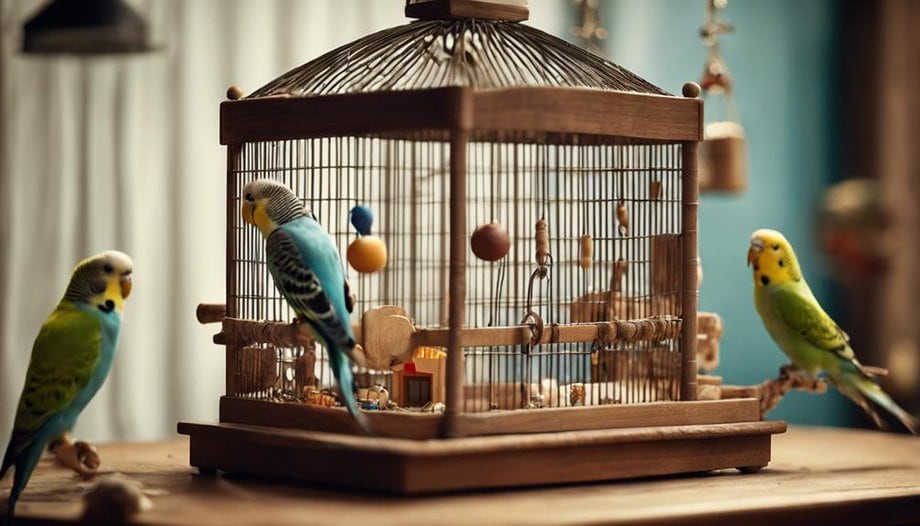
To ensure your budgerigar’s cage is engaging and enriching, selecting a variety of perches and toys is essential. Providing different perches of varying thicknesses and textures helps exercise your budgie’s feet and prevent foot issues. Likewise, rotating toys frequently keeps your budgie mentally stimulated and prevents boredom.
Perch Variety, Toy Rotation:
- Perch Variety: Include natural wood, cement, and rope perches to promote foot health.
- Toy Rotation: Regularly switch out toys to maintain your budgie’s interest and mental engagement.
- Playtime Schedule: Establish a consistent daily playtime routine to bond with your budgie.
- Interaction Benefits: Engaging in interactive play with your budgie fosters trust and strengthens your bond.
Food and Water Dishes

When setting up a budgerigar (budgie) cage, it’s crucial to consider the proper placement of food and water dishes. Regular cleaning of these dishes is essential to ensure the health and well-being of the bird.
Additionally, selecting the appropriate size of dishes will help prevent spills and keep the cage organized.
Proper Dish Placement
Where should you position the food and water dishes inside the budgie cage for optimal accessibility and cleanliness?
It’s essential to consider the budgie’s comfort and safety when deciding on the placement of their food and water dishes.
Here are some key points to keep in mind:
- Height: Place the dishes at a comfortable height for the budgie to access easily.
- Accessibility: Ensure the dishes are easily reachable without the budgie having to stretch too much.
- Separation: Keep the food and water dishes in different areas of the cage to prevent contamination.
- Stability: Secure the dishes in place to prevent spills and ensure the budgie’s environment remains clean and hygienic.
Dish Cleaning Routine
Considering the importance of maintaining a clean and hygienic environment for your budgerigar, establishing a regular dish cleaning routine for both the food and water dishes is crucial.
To ensure the health and well-being of your feathered friend, it’s recommended to wash the dishes daily with mild soap and hot water, thoroughly rinsing them afterward. Implementing a weekly sanitizing schedule using a pet-safe disinfectant can further prevent harmful bacteria growth.
Additionally, incorporating toy rotation and regularly disinfecting the cage and accessories can help maintain a safe and healthy environment for your budgie. By following these practices diligently, you provide a clean and enjoyable space for your budgerigar to thrive.
Dish Size Considerations
To ensure the comfort and well-being of your budgerigar, selecting appropriately sized food and water dishes is essential for their ease of access and usage in the cage. When considering dish sizes, keep the following in mind:
- Provide a variety of perch sizes: Different perch thicknesses help exercise your budgie’s feet and prevent foot issues.
- Choose suitable toys: Select toys that encourage physical activity and mental stimulation for a happy and healthy bird.
- Use a water bottle: This helps maintain cleanliness and prevents water contamination from droppings.
- Offer a balanced seed mix: Ensure a mix that includes a variety of seeds, fruits, and vegetables to provide essential nutrients for your budgie’s diet.
Bedding and Substrate
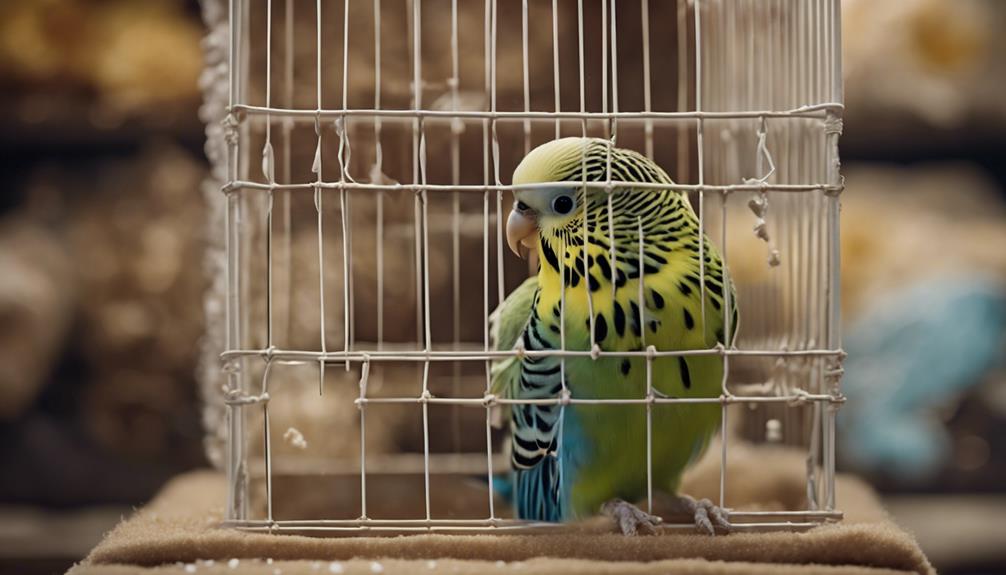
Consider using a soft paper-based bedding material to line the bottom of your budgerigar cage for comfort and ease of cleaning. When selecting bedding options for your budgie’s cage, prioritize safety by avoiding materials that could be harmful if ingested. Opt for paper-based bedding as it’s safe for your bird and provides a comfortable surface for them to walk on.
Additionally, paper bedding is easy to clean and replace, promoting a hygienic environment for your feathered friend.
For substrate types, you may choose from various options such as paper pulp, shredded paper, or recycled paper products. These substrates offer benefits like absorbency, odor control, and dust-free properties, ensuring a healthy living space for your budgerigar.
Paper-based substrates are also cost-effective and readily available at pet stores.
Cleaning and Maintenance
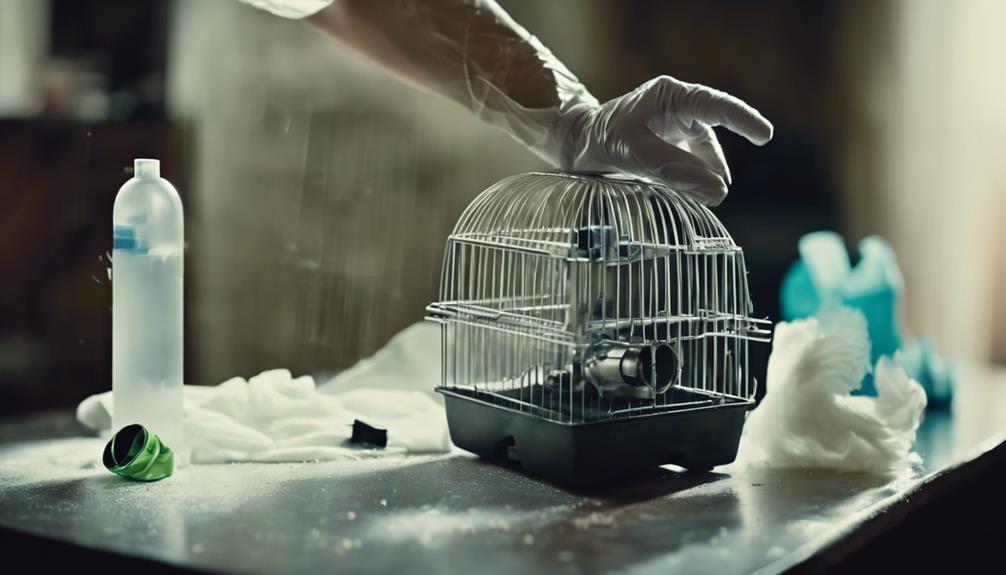
Maintaining a clean and hygienic budgie cage is crucial for the health and well-being of your feathered friend. Establishing a regular cleaning schedule and adhering to proper maintenance practices are essential tasks for any budgie owner.
Understanding cage hygiene tips, knowing how often to clean, and having the right tools for maintenance are key aspects to consider.
Cage Hygiene Tips
Regular cleaning and maintenance of the budgerigar (budgie) cage is essential to ensure the health and well-being of your feathered companion. To maintain a hygienic environment for your budgie, here are some key tips to follow:
- Ensure Proper Cage Ventilation: Good airflow helps prevent the buildup of harmful bacteria and keeps the cage fresh.
- Implement Odor Control Measures: Use pet-safe deodorizers or baking soda to control any unwanted smells.
- Choose Suitable Cage Accessories: Opt for easy-to-clean perches, toys, and feeders to simplify cage maintenance.
- Consider Nesting Options: Provide a clean and cozy nesting area for your budgie to encourage natural behaviors.
Cleaning Schedule Advice
To ensure optimal cleanliness and health for your budgerigar (budgie), establish a consistent cleaning schedule for the cage. Cage cleanliness is paramount for the well-being of your feathered friend. Regular maintenance and upkeep are essential to prevent the buildup of waste, bacteria, and odors.
Aim to clean the cage thoroughly at least once a week by removing droppings, changing the lining, and wiping down all surfaces with a pet-safe disinfectant. Additionally, daily spot cleaning should be performed by removing any soiled bedding or uneaten food.
Keeping the cage hygienic not only promotes a healthier environment for your budgie but also helps maintain a pleasant living space for both you and your pet.
Maintenance Essentials
Ensuring the cleanliness and hygiene of your budgerigar (budgie) cage involves a combination of regular cleaning and maintenance tasks to promote a healthy environment for your feathered companion. Here are some maintenance essentials for your budgie’s cage:
- Regular Cleaning: Clean the cage bottom, perches, and toys weekly.
- Cage Decoration: Rotate and clean decorations monthly to prevent bacterial growth.
- Budgie Training: Use cleaning time for training to build trust with your bird.
- Cage Accessories: Check and replace damaged accessories to avoid injury.
Enrichment and Socialization
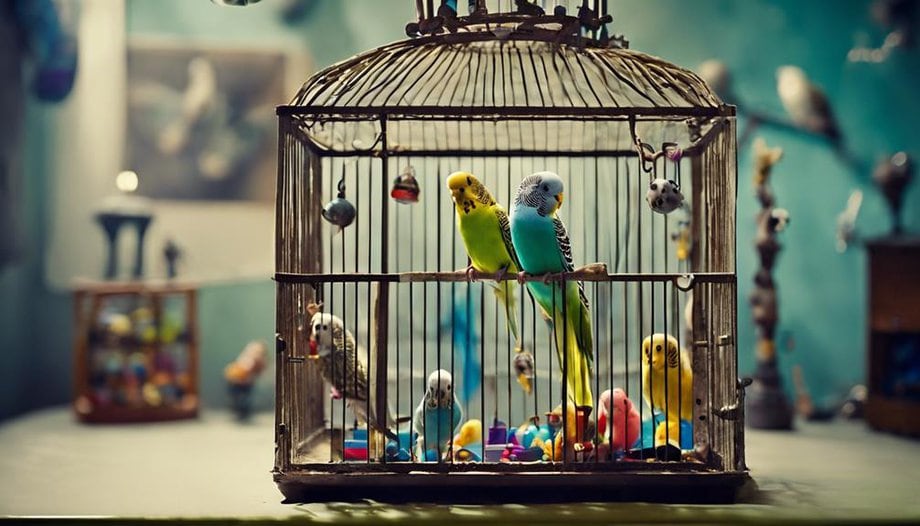
Creating a stimulating environment and promoting social interactions are crucial aspects of ensuring the well-being of your budgerigar in its cage. Behavioral training and playtime are essential for keeping your budgie mentally and physically active. Incorporating interactive toys like bells, mirrors, and ropes can help prevent boredom and encourage natural behaviors like climbing and chewing. Providing a variety of perches at different heights within the cage can also offer mental stimulation and exercise.
Companion birds play a vital role in the social bonding of budgerigars. If possible, consider housing your budgie with a same-species companion to prevent loneliness and encourage natural social behaviors. Regular social interactions with your budgie through gentle handling and positive reinforcement can help build trust and strengthen your bond.
Frequently Asked Questions
Can Budgerigars Be Housed With Other Types of Birds in the Same Cage?
Budgerigars can’t be housed with other bird species due to potential conflicts. They require companionship with their own kind for socialization. Ensuring a spacious cage that meets their space needs is crucial for their well-being.
How Often Should Budgie Cages Be Disinfected to Prevent Illness?
Regular cleaning of budgie cages, such as weekly disinfection, is essential for preventing illness and maintaining health. Using bird-safe disinfectants like vinegar solutions or commercial products can help keep the cage environment safe and germ-free.
Are There Any Specific Types of Plants or Flowers That Should Not Be Placed Near a Budgie Cage?
Like a gardener avoiding thorns, it’s wise to steer clear of toxic plants near a budgie cage. Opt for bird-safe flowers and ensure cage accessories and playtime routines are free from potential hazards.
How Can I Train My Budgie to Use Specific Perches or Toys in the Cage?
When training a budgie to use specific perches or toys, observe behavioral cues for interest. Offer rewards like treats or positive reinforcement when the budgie interacts with the desired items. Consistent training tips and patience are key.
What Types of Environmental Enrichment Activities Are Best for Budgerigars to Prevent Boredom and Encourage Mental Stimulation?
To keep budgerigars mentally stimulated and prevent boredom, providing foraging activities like puzzle toys, chewable toys, and climbing structures is essential. These items engage their natural instincts, encouraging a healthy and active lifestyle.



